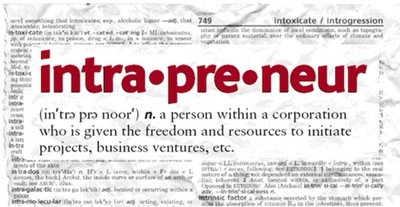I discovered a new word last summer: intrapreneur.
I was reading Richard Branson’s Like a Virgin which is a great book of short chapters giving advice on business and leadership when I stumbled across the word. Branson defines an intrapreneur as:
‘am employee who is given freedom and financial support to create new products, services and systems, who does not have to follow the company’s usual routines or protocols’.
Branson goes on to say that: ‘while it’s true that every company needs an entrepreneur to get it under way, healthy, innovative growth requires a smattering of intrapreneurs who drive new projects and explore new and unexpected direction for business development’ and he gives examples of how Virgin could never have grown as it has without a steady stream of these kind of people.
I was excited about what I was reading as at last I was finding language for something that I’d observed but never been able to properly articulate and define. Branson was talking about releasing leaders to pioneer something new – but rather than send them out to do it on their own, they could do it as part of the parent organisation. As I read I began to think that every sector of society needs to identify and release the intrapreneurs. Including the church.
So I was really pleased to go to The Belfrey’s G2 congregation yesterday and encourage them to be intrapreneurs for God’s kingdom! G2 is one of the larger Fresh Expressions of church in the UK and they’re doing a great job. We prayed for the new expanded Core Team of leaders and I commissioned them to unashamedly be a satellite church of The Belfrey. As a church within a church, they have permission to push the boundaries, try innovative things and press on in creative mission within good accountable relationships. G2 is a great example of intraprenuerial church development.
G2 – like other parts of The Belfrey – has some really great leaders emerging. Leaders with vision. Interestingly Branson says that if you want to get the most out of intrapreneurs, ‘the key is to enable them to pursue their vision.’ I agree. Which is why I expect to see some wonderful new ventures bubbling out of G2 in the coming months and years, as great leaders with God-inspired vision are released to plant churches.
So why don’t we see more intrapreneurs? In business? In education and medicine and the charity sector? And – as this is a discipleship blog – in church? Well it seems to me that one of the sticking points is managers. Managers are crucial in any organisation. We need them. But managers tend to be more concerned with systems, structures and processes than growth and development. Managers think intrapreneurs don’t ‘fit’ and don’t do things properly. Which is why the role of senior leaders is crucial. The senior leader – who probably understands the need for growth and innovation more than most in the organisation – needs to stop the managers from crushing the vision and passion of the intrapreneurs. The senior leader has a key role in setting the intrapreneur free. That’s why Branson astutely asks: ‘what if CEO stood for “Chief Enabling Officer”? What if that CEO’s primary role were to nurture a breed of intrapreneurs who would grow into tomorrow’s entrapreneurs?’
All this applies to the church as we aim to grow more disciples, more leaders and more churches. Pray for God to be raising more leaders in our day with vision and passion to develop, innovate and pioneer. Pray for senior leaders who have the capacity to lead both the managers and the pioneers. And pray that intrapreneurial vision will not be crushed but liberated in the church of our day. We need the intrapreneurs.



Intrapreneur is a great term! I went over and did the full entrepreneur thing, but definitely would have benefited from having the freedom of an intrapreneur when I was still working for a company. It may have kept me there longer…
I have discovered a new name for my job – intrapreneurial!
One of the key issues within the current “managerial” construct (IMHO) is the perception and understanding of “failure” in relation to discovery, growth or development. Pioneer ministry is an attempt to capture this sense of dynamism (and it does it very well!) but I do think that a a re-shaping of the metrics that are used to “measure” success in the church is fundamental to the further development of an “intrepreneurial” spirit that needs to become part of the DNA of any organisation.
One of the best models for organisational development and entrepreneurship (that it seems you have described in part here) within a hierarchical organisation is the Viable System Model which allows for an almost fractal level of ownership+authority if properly implemented, with weighted vertical traction. The development of these viable units to respond and adapt to their own immediate environment with actuators and influence points that establish, dampen or enlarge the impact on the wider “organism” can greatly enhance the manoeuvrability and responsiveness of an organisation however, conversely is DOES require a management structure with the specific role of managing the “fizz” created from all sides and directing the kinetic energy generated.
These units (or Viable Systems) become almost the embodiment of Senior Leaders on an environmental level.
Was pointed to this blog by a friend – keep up the great posts!
This is excellent!